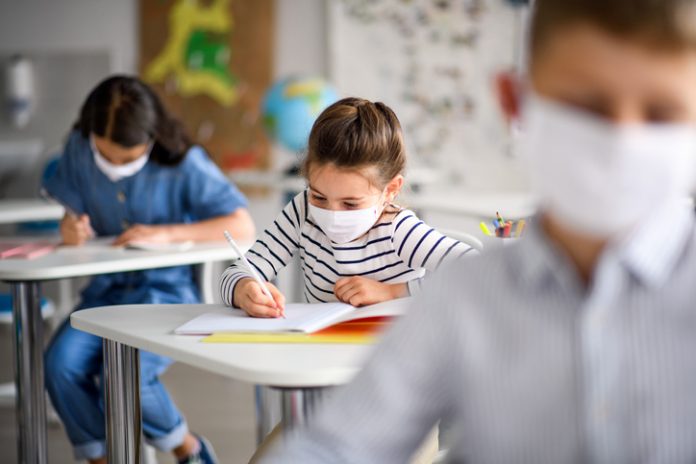Three feet is proving to make a difference in the speed at which public school districts are reopening classrooms for face-to-face instruction.
In its March 29 report, Burbio, a data service that tracks school openings, noted the first combined drop in the number of virtual and hybrid arrangements, indicating a positive trajectory for getting schools back to traditional in-person settings. As of April 12, 59.4 percent of students nationwide are back in classrooms, full-time, every day while 2.5 percent of school districts are virtual only (12. 2 percent of all students, nationwide).
On March 19, the U.S. Centers for Disease Control and Prevention (CDC) updated its guidelines for physical distancing from six feet to three, a change that has made a profound difference for small shops, restaurants, churches, event venues but especially schools. The CDC said it made the change after its own studies showed children were safe from COVID-19 being within 3 feet of one another. The agency still recommends that children mask up.
The agency has come under scrutiny in recent months for delaying approval for school openings, even as international health organizations and medical experts cite the lack of evidence and negative impact of prolonged closures. The CDC said it made the change after its own studies showed children were safe being within 3 feet of one another.
“The scientists at the World Health Organization have determined that schools should only be closed ‘as a last resort if hospitals are at risk of being overwhelmed,” said Chad Savage, MD, founder of YourChoice Direct Care in Brighton, MI. “If the hospitals are not at risk of being overwhelmed, and the broader society can be open, so too should schools.”
Mixed School Response
In response to the CDC’s revised social distancing guidelines, Burbio’s data show K-8 students are driving the trend in school re-openings with 16.3 percent of K-12 students limited to virtual-only learning and 53.1 percent having access to traditional in-person attendance.
Burbio’s weekly update for the last week in March noted “heavily virtual” states such as Oregon, California,Washington, Maryland, Washington, DC , and New Jersey revised their regulations to reflect the 3-feet guidance. The state of Maine reiterated its use of a three-feet distancing standard for students which it put into effect in July 2020.
Burbio found, despite the shorter social distancing guidelines, five districts have refused to reopen classrooms: Kalamazoo, Michigan, Passaic, New Jersey, Santa Ana, California, San Bernadino City, California, and South San Francisco, California.
Also noted in the update was the CDC’s failure to adjust guidelines for quarantining alongside social distancing changes for in-person learning. Some districts are wary of still stringent, contact tracing guidelines.
Closed Schools Hurt Lifetime Earnings
The refusal of public schools to reopen could costs students in lifetime income. A September 2020 report by OECD finds that students will have lost three percent of earnings from missing just one-third of the school year. Many schools have remained closed for nearly a full year.
The overall U.S.economy loses from school closures. A report in Barron’s puts the price tag at $700 billion.
The impact on the economy is what prompted Blurio to get into the school tracking business. “When COVID hit, we started building tools for business intelligence as community and school opening activity affects so many parts of the economy,” said Dennis Roche, the co-founder of Burbio. “We built it from the county level as that is how economic life is measured. And whether schools were virtual, in-person every day, or hybrid affects many elements of the economy.”
The Teachers’ Union Connection
When schools first closed, it was under the presumption of dealing with an unknown virus and its unknown impact on hospital capacity.
However, new evidence looking at schools in Las Vegas, Nevada shows school closures are closely linked to how long teachers’ unions linger at the bargaining table. Teachers have claimed that they are at risk for getting sick and even dying from COVID-19, but teachers who can often start collecting pensions in their 50’s, are unlikely to be in the age group most at risk from COVID-19 complications. Additionally, vaccines now are widely available to teachers.
“Teachers’ unions are rapidly running out of excuses not to have schools open,” Savage told Health Care News. “We already know that teachers are at no higher risk of becoming infected than the background population and that the closures are having profound and potentially life-long harms to our children. If we are basing this on science, teachers’ unions should have no excuse for decisions regarding schools closed under the pretext of COVID to be based on anything other than COVID hospital capacity itself.”
Ashley Bateman (bateman.ae@googlemail.com) writes from Alexandria, Virginia.
Internet info:
Eric A. Hanushek, Judger Woessmann, “The Economic Impacts of Learning Losses.” September 2020, OECD: https://www.oecd.org/education/The-economic-impacts-of-coronavirus-covid-19-learning-losses.pdf





















